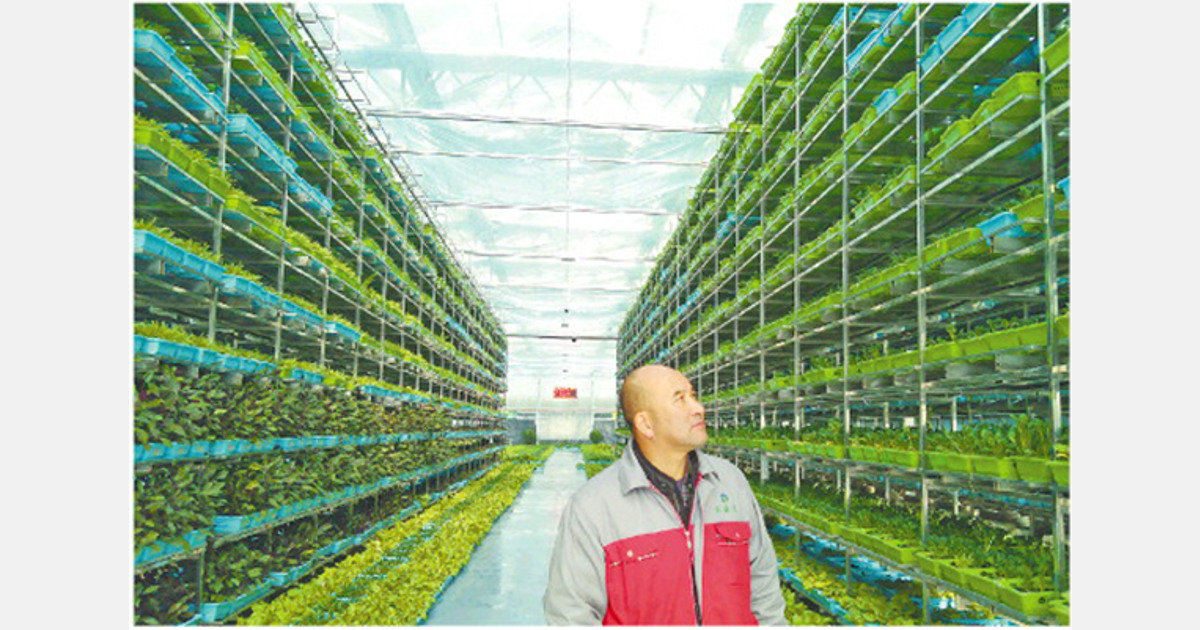
The 10-layer vertically potted plants can grow up to 16 cycles of vegetables a year, with an average output value of 45 million RMB (Chinese Yuan) per hectare. This set of data alone is enough to surprise old growers.
Recently, a Dazhong Daily reporter visited the Organic Smart Factory in Yukesong Digital Agriculture Industrial Park, Fangzi District, Weifang City. In this vertical glass greenhouse covering an area of over 1 hectare, he explored the mystery of the ten-story building for vegetables. Walking into the automatic glass door, there was a sound of running water, and colorful ornamental fish swimming around under the tempered glass floor. Entering another glass door, the green vegetables placed high up will show up. The monitor at the end of the vertical planting racks shows real-time data: soil temperature is 13.7°C and air humidity is 68.6%RH.
The park uses various technologies including vertical planting, air distribution, water cycle temperature adjustment, crop lighting, microbial cycle, water and fertilizer integrated automatic control technology, to achieve an intelligent automatic adjustment system for temperature, humidity, and light, with a daily output production of 10,000 kg of organic vegetables and the average output value per hectare is 45 million RMB.
Currently, the park has established vegetable bases in Shanghai and other places and used channels such as JD.com and Alibaba for online sales. It has established a complete traceability system from seedlings to dining tables, and the supply of products exceeds demand. In addition to using the online sales model, they also created a "balcony family farming" concept for urban citizens. In this way, others can grow on their own balcony.
Unlike the greenhouse that the reporter visited when the cold wave hit, there was no heating device or burning residue in the greenhouse. "This sound of water is our secret of keeping out the cold. The outdoor temperature was as low as -21℃ a few days ago, and some greenhouses dropped to -5℃, and heating measures had to be adopted. However, we used circulating water to heat up, and the temperature inside the greenhouse was 9 ℃, the electricity cost is less than 1/10 of their heating cost." Mr. Zhang Xianliang, the manager of Yukesong Digital Agriculture Industrial Park, told the reporter that recycled water is the "core technology" in the greenhouse. After the groundwater is filtered and recycled, it can not only heat up in winter and cool down in summer, but also breed ornamental fish.
In this over 1-hectare vertical glass greenhouse, 5 workers are maintaining the Malabar spinach and mountain begonia. "These products have to be sent to customers these days. The area that used to require 50 staff to manage, now through automated management, only five or six employees are needed, output efficiency has increased, and labor costs have been greatly reduced. "Mr. Zhang said.
The use of technology makes farm management more convenient. In September 2020, the park got more experienced in logistics and warehousing as they built the Yukesong Digital Agriculture Industrial Park through IoT management. Over 1 hectare of land is equivalent to more than 10 hectares of planting area, whereas 200,000 pots of leafy vegetables can be placed at one time. However, technology only is not enough for agricultural planting, but it also requires experience.
After planting for a period of time, Mr. Zhang and others found that the Chinese cabbage and small bok choy looked "weak and unhappy", the stems and leaves were not well-developed, and the growth was too slow. "The soil is organic, mixed by technicians, and there is no shortage of nutrients. So what is the problem? they thought by themselves."
Growers working in the park suggested if there were a lack of light as the bottom vegetables wouldn't get any.” That opinion was not unreasonable. When the planting racks were installed, artificial lights were installed on purpose. The bottom planting rack makes use of three artificial lights instead of one. However, the problem of poor growth of some vegetables is still unsolved.
In the end, the problem was solved by placing the Chinese cabbage and small bok choy on the upper floor. "Actually, it is still a problem that several vegetables have different lighting- and oxygen needs to other vegetables. Now we're planning to place different vegetables, mushrooms and sprouts on the bottom layer. The oxygen produced during the mushroom growth will supply the upper leafy vegetables to make the leafy vegetables grow better. The lower three layers are filled with vegetables that don’t like direct light such as mushrooms, Malabar spinach, and so on. At the upper layer, small cabbage and bok choy are planted. "Mr. Zhang said.
The vegetables in the vertical glass greenhouse are growing well as the Yukesong Digital Agriculture Industrial Park implements "science and technology for agriculture". The park has hired more than 30 experts and professors from the University of California, the Chinese Academy of Agricultural Sciences, Shandong Agricultural University, and other institutions. This is done to introduce and promote over 20 advanced technologies such as organic seedlings, vertical farming, biological fertilizers, and others, from the United States, Israel, the Netherlands, and other countries.
Source: dzrb.dzng.com
"Factory" - Google News
April 15, 2021 at 07:21PM
https://ift.tt/2RBSKyW
China: Organic Smart Factory implements science and technology for agriculture - hortidaily.com
"Factory" - Google News
https://ift.tt/2TEEPHn
Shoes Man Tutorial
Pos News Update
Meme Update
Korean Entertainment News
Japan News Update
Bagikan Berita Ini














0 Response to "China: Organic Smart Factory implements science and technology for agriculture - hortidaily.com"
Post a Comment